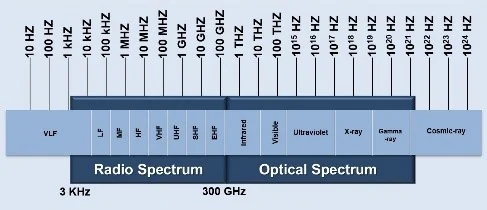The use of very high frequencies for communication has always been “just around the corner,” where because of significant technical challenges, it's remained for 50 years. Now, faced with scarce spectrum available at lower frequencies, the wireless industry is determined to overcome those challenges.
The fifth generation of wireless communications, commonly called “5G”, will be a technology tour de force once it's rolled out after 2020. One of its most impressive accomplishments will be the use of radio frequencies far, far higher than have ever been used for cellular networks or almost anything else, a region called millimeter wavelengths. This is a very big deal for many reasons. But first, it's important to understand how these frequencies fit into the spectral landscape, how they differ from their lower-frequency counterparts, and why except for satellite communications, vehicle radar, and defense systems, they've not been used.
The electromagnetic spectrum is massive in its breadth, covering frequencies from 1Hz (the domain of lightning) to above 10 exahertz (10EHz, or 10 quintillion hertz, where gamma rays live)。 The region between about 1MHz and 300GHz is where communications can take place, of which only a tiny portion is actually used (1MHz to 30GHz)。 And of that, less than 20 percent (about 6GHz) is densely populated by wireless communications systems including shortwave, AM, FM, TV broadcasting, cellular, amateur radio, and land mobile radio, as well as assorted unlicensed applications like Wi-Fi, Bluetooth, ZigBee, microwave ovens, and industrial and medical systems. This is the “sweet spot” where communications over significant distances can be accomplished, ranging from spanning the world at the low end to a few miles at the high end (Figure 1)。

Figure 1: The millimeter-wave portion of the spectrum, also called Extremely High Frequency (EHF) is generally defined as beginning at 30GHz and extending to 300GHz. (Source: NASA)
However, the swath of spectrum between about 150MHz and 1GHz is prime spectral real estate because it poses fewer challenges such as signal loss, the ability to penetrate buildings, glass, and other impediments, while offering wide-area coverage. So it's not surprising that this region accounts for almost all communications throughout the world, an increasing problem as there is precious little unused spectrum left. Thus, the FCC can auction remarkably narrow slices of this spectrum for billions of dollars.
So now the powers that determine the future of wireless communications have determined that it will collectively venture into the relatively unexplored spectral frontier as high as 60GHz and eventually even 100GHz, which is 10 to 100 times higher than ever before. On the face of it, this is certainly logical, but as always the devil is in the details, and they account for why millimeter-wave frequencies have never been widely used.
Generally speaking, as frequencies increase, signal attenuation through the air, communication distance, and the ability to penetrate solid objects decrease. At the highest frequencies proposed for 5G, for example (60GHz), almost anything in the path of the signal (even foliage) will scatter or absorb it. In addition, in order to provide sufficient signal strength to many users, high-gain antennas along with beamforming, diversity, and multi-user, Multi-Input Multi-output (MIMO) techniques will be required. MIMO and diversity are widely used today for Wi-Fi access points and most recently in some smartphones. At millimeter-wave frequencies, it will be necessary to truly massive MIMO (dozens of antennas) to make communication possible. Beamforming—combining antenna beams and aiming them at specific points—is currently used almost exclusively in defense systems. In short, exploiting the potential of these very high frequencies is far from trivial.
So why would the entire wireless industry dedicate itself to such a massive challenge? Well first, as few services operate in this region, it's a massive, untapped spectral resource akin to discovering the world's largest oil or natural gas deposits. It could virtually eliminate spectrum shortages forever, enable the extremely wide channel bandwidths required to accommodate gigabit-per-second data rates, and create new revenue opportunities for communications providers. For example, Verizon and AT&T have already expressed interest in using millimeter-wave frequencies to deliver broadband and entertainment services, placing them in direct competition with cable and fiber.
Expanding into the millimeter-wave region will also be a windfall for manufacturers of semiconductor devices whose characteristics make them well suited for use at these high frequencies as well as for manufacturers of many other types of components. It will essentially create a market segment that simply doesn't exist today. Modules that cover broad frequency ranges will be increasingly important in order to cover many communication bands in a single device.
The Analog DevicesHMC-C038 (Figure 2) distributed driver amplifier module is a good example, as it operates from 2 to 35GHz encompassing many cellular frequencies as well as those used by satellite communications, radar, electronic warfare, and wideband test equipment. The GaAs delivers an RF output of +14dBm from 27 to 35GHz and extremely flat gain response of +/-0.5 or less from 2 to 27GHz and +/-1.5 dB from 27 to 35GHz.

Figure 2: The Analog Devices HMC-C038 driver amplifier module has extremely wide frequency coverage of 2 to 35GHz.
Research firm Marketandmarkets projects that the global millimeter-wave market, which accounted for $346.8 million in 2015, will rise to $4.63 billion by 2022 with an average growth rate of 43% per year. Most of this growth will be from the increased use of millimeter-wave frequencies for backhaul of data from small cell base stations, but as 5G will only just be appearing around 2022, growth in the following years might be even greater.
The Tip Of The Iceberg?
While the fifth generation of cellular will be the primary market driving the increased use of millimeter-wave spectrum it won't be the only one. Satellite communications systems have long resided at these frequencies and Point-to-Point (P2P) and Point-to-Multipoint (PMP) microwave links are widely used in place of optical fiber for high-speed cellular backhaul and networks that require extremely low latency. In addition, as technologists create solutions to the inherent drawbacks of millimeter wavelengths, it's likely that new short-range communication applications will emerge, and those in development will become available.
For example, the IEEE 802.11ad standard operating at 60GHz championed by the Wi-Fi Alliance began certification in October and some products are already available. It's likely that the next generation of smartphones coming in 2017 will add WiGig to existing Wi-Fi standards operating at 2.4 and 5GHz. WiGig is designed for connecting devices over short distances up to about 100 ft. with low latency and data rates up to 8Gb/s. It should allow multiple Ultra-High-Definition (Ultra HD) videos and movies to be streamed or downloaded simultaneously, provide more immersive gaming and virtual reality, and use beamforming and dynamic switching between Wi-Fi standards operating at 2.4, 5, and 60GHz to reduce interference and improve connectivity.
Although there are many hurdles to overcome to fully realize the potential of millimeter-wave communications, there is little doubt that it will be worth the effort. Not only will it pave the way for cellular communications long into the future, it will inevitably result in new applications and enhance those that already exist.


